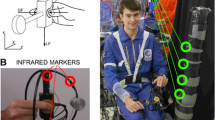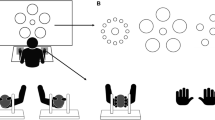Abstract
Passing objects from one hand to the other occurs frequently in our daily life. What kind of information about the weight of the object is transferred between the holding and lifting hand? To examine this, we asked people to hold (and heft) an object in one hand and then pick it up with the other. The objects were presented in the context of a size–weight illusion: that is, two objects of different sizes but the same weight were used. One group of participants held one of the objects in their left hand and then picked it up with their right. Another group of participants simply picked up the objects from a table. Thus, the former group had on-line information about the weight of the object, whereas the latter did not. Both groups showed a strong and equivalent size–weight illusion throughout the experiment. At the same time, the group that lifted the objects from the hefting hand applied equal grip force to the small and large object right from the start; in contrast, the group lifting the objects from the table, initially applied more grip force to the large than to the small object before eventually applying the same force to both. In two additional groups, a delay period was imposed between the lifting of the first and the second hands. The force parameters employed by these last two groups were virtually identical to those used by the group that lifted the object directly from the other hand. These results suggest that the initial calibration of grip force uses veridical information about the weight of the object provided by the other hand. This veridical information about weight is available on-line and is retained in memory for later access. The perceived weight of the object is basically ignored in forming grasping forces.





Similar content being viewed by others
References
Brainard DH (1997) The psychophysics toolbox. Spat Vis 10:433–436
Brenner E, Smeets JB (1996) Size illusion influences how we lift but not how we grasp an object. Exp Brain Res 111:473–476
Charpentier MA (1891) Analyse experimentale: De quelques elements de la sensation de poids. Arch Physiol Norm Pathol 3:122–135
Criscimagna-Hemminger SE, Donchin O, Gazzaniga MS, Shadmehr R (2003) Learned dynamics of reaching movements generalize from dominant to nondominant arm. J Neurophysiol 89:168–176
Diedrichsen J, Verstynen T, Hon A, Lehman SL, Ivry RB (2003) Anticipatory adjustments in the unloading task: is an efference copy necessary for learning? Exp Brain Res 148:272–276
Dufosse M, Hugon M, Massion J (1985) Postural forearm changes induced by predictable in time or voluntary triggered unloading in man. Exp Brain Res 60:330–334
Flanagan JR, Beltzner MA (2000) Independence of perceptual and sensorimotor predictions in the size–weight illusion. Nat Neurosci 3:737–741
Flanagan JR, Wing AM (1997) The role of internal models in motion planning and control: evidence from grip force adjustments during movements of hand-held loads. J Neurosci 17:1519–1528
Flanagan JR, King S, Wolpert DM, Johansson RS (2001) Sensorimotor prediction and memory in object manipulation. Can J Exp Psychol 55:87–95
Flanagan JR, Bowman MC, Johansson RS (2006) Control strategies in object manipulation tasks. Curr Opin Neurobiol 16:650–659
Gordon AM, Forssberg H, Johansson RS, Westling G (1991a) The integration of haptically acquired size information in the programming of precision grip. Exp Brain Res 83:483–488
Gordon AM, Forssberg H, Johansson RS, Westling G (1991b) Visual size cues in the programming of manipulative forces during precision grip. Exp Brain Res 83:477–482
Gordon AM, Westling G, Cole KJ, Johansson RS (1993) Memory representations underlying motor commands used during manipulation of common and novel objects. J Neurophysiol 69:1789–1796
Gordon AM, Forssberg H, Iwasaki N (1994) Formation and lateralization of internal representations underlying motor commands during precision grip. Neuropsychologia 32:555–568
Grandy MS, Westwood DA (2006) Opposite perceptual and sensorimotor responses to a size–weight illusion. J Neurophysiol 95:3887–3892
Henningsen H, Endehenningsen B, Gordon AM (1995) Asymmetric control of bilateral isometric finger forces. Exp Brain Res 105:304–311
Hu Y, Goodale MA (2000) Grasping after a delay shifts size-scaling from absolute to relative metrics. J Cogn Neurosci 12:856–868
Johansson RS, Westling G (1984) Roles of glabrous skin receptors and sensorimotor memory in automatic control of precision grip when lifting rougher or more slippery objects. Exp Brain Res 56:550–564
Johansson RS, Westling G (1988) Coordinated isometric muscle commands adequately and erroneously programmed for the weight during lifting task with precision grip. Exp Brain Res 71:59–71
Kaluzny P, Wiesendanger M (1992) Feedforward postural stabilization in a distal bimanual unloading task. Exp Brain Res 92:173–182
Kinoshita H, Backstrom L, Flanagan JR, Johansson RS (1997) Tangential torque effects on the control of grip forces when holding objects with a precision grip. J Neurophysiol 78:1619–1630
Malfait N, Ostry DJ (2004) Is interlimb transfer of force-field adaptation a cognitive response to the sudden introduction of load? J Neurosci 24:8084–8089
Massion J (1992) Movement, posture and equilibrium: interaction and coordination. Prog Neurobiol 38:35–56
Milner D, Goodale MA (2006) The visual brain in action. Oxford University Press, USA
Murray DJ, Ellis RR, Bandomir CA, Ross HE (1999) Charpentier (1891) on the size–weight illusion. Percept Psychophys 61:1681–1685
Oldfield RC (1971) The assessment and analysis of handedness: the Edinburgh inventory. Neuropsychologia 9:97–113
Pelli DG (1997) The VideoToolbox software for visual psychophysics: transforming numbers into movies. Spat Vis 10:437–442
Quaney B, Rotella DL, Peterson C, Cole KJ (2003) Sensorimotor memory for fingertip forces: evidence for a task-independent motor memory. J Neurosci 23(5):1981–1986
Zwislocki JJ, Goodman DA (1980) Absolute scaling of sensory magnitudes: a validation. Percept Psychophys 28:28–38
Acknowledgments
The authors would like to thank Dr. Joern Diedrichsen and two other anonymous reviewers for their constructive comments. The authors are also indebted to Haitao Yang for his technical assistance. This research was supported by grants to M. A. Goodale from the Canadian Institutes of Health Research and the Canada Research Chairs Program. E. C. Chang was supported by a grant from the CIHR Strategic Training Program in Vision Health Research.
Author information
Authors and Affiliations
Corresponding author
Rights and permissions
About this article
Cite this article
Chang, E.C., Flanagan, J.R. & Goodale, M.A. The intermanual transfer of anticipatory force control in precision grip lifting is not influenced by the perception of weight. Exp Brain Res 185, 319–329 (2008). https://doi.org/10.1007/s00221-007-1156-0
Received:
Accepted:
Published:
Issue Date:
DOI: https://doi.org/10.1007/s00221-007-1156-0




